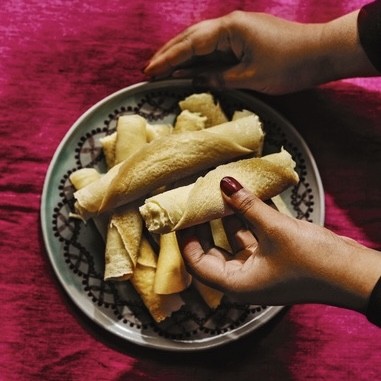Patishapta | Rice Crêpes with Cardamom Rice Cream
Patishapta | Rice Crêpes with Cardamom Rice Cream

Servings
16
Prep Time
1 hour
Cook Time
45-60 minutes
"Patishapta is a favourite pitha or rice pastry across Bangladesh and among the Bangladeshi diaspora. It’s one of the pithas made during Poush Shakrain, which marks the end of the Bengali month of Poush as well as Pôhela Boishakh, the Bangladeshi New Year. You’ll find these exquisite sweet treats being made to order at street-food carts, lining the glass cases of confectionery stores, and being served at family get-togethers. The pitha or pastry itself is thin and crêpe-like, and usually conceals one of two delightful fillings: a sticky blend of coconut and molasses, or a creamy mixture called kheer or rice pudding. While I am hard pressed to choose between the two, the kheer-filled ones are most requested by my family for cha nasta."
Excerpted with permission from Made in Bangladesh: Recipes & Stories from a Home Kitchen by Dina Begum. ©2023. Published by Hardie Grant.
Author:Dina Begum
Ingredients
2 Tbsp vegetable oil
75 g (2 ½ oz/scant 2/3 cup) fine semolina
75 g (2 ½ oz/scant ½ cup) rice flour
150 g (5 ½ oz/1 ¼ cups) plain (all-purpose) flour
1 Tbsp granulated sugar
-
1⁄8 tsp salt
250 ml (8 fl oz/1 cup) full fat milk
250 ml (8 fl oz/1 cup) room-temperature water
30 g (1 oz) rice flour
30g (1 oz/¼ cup) fine semolina
400 ml (14 fl oz/generous 1 ½ cups) full-fat milk
-
¼ tsp ground cardamom
-
several strands of saffron
230 ml (8 oz) condensed milk
FOR THE BATTER:
FOR THE KHEER FILLING:
Directions
To make the batter, combine the semolina, rice flour, plain flour, sugar and salt in a mixing bowl. Pour in the milk and measured water and whisk well, ensuring there are no lumps. Cover and set aside for 1 hour.
Meanwhile, make the kheer filling by placing all the ingredients except the condensed milk into a saucepan.
Stir the mixture well and cook over a low–medium heat for 10–12 minutes, stirring continuously. Add the condensed milk and continue cooking until the mixture thickens; it should be the consistency of choux pastry, and fall off very slowly. Tip the mixture on to a plate and spread out to cool. It will thicken further as it cools. Once cool, use a knife to divide the kheer into 16 portions. Roll each into 13 cm (5 in) logs and set aside.
When you’re ready to cook the patishapta, whisk the batter to ensure a uniform mixture, then heat a frying pan over a low–medium heat. Brush very lightly with oil using a pastry brush and, once the oil is hot, add a small ladleful of batter to the pan, swirling the pan as you go, to create a thin crêpe, 15 ½ cm (6 in) in diameter. Cook for 1 minute, until the batter becomes opaque and bubbles appear on the surface. The batter should remain pale on the underside and not take on too much colour.
Place a portion of the kheer on the crêpe, slightly off centre. Once the filling is in place, immediately lift one side of the crêpe with a spatula and fold over the filling, then fold twice more, to form a roll. Remove from the pan and set aside on a plate. Repeat until you’ve used up all the batter and filling, greasing the pan after cooking every patishapta. You can serve immediately, or at room temperature. Once cool, the pitha can be stored in the refrigerator, in an airtight container, for 2–3 days.
Recipe Note
Made in Bangladesh: Recipes & Stories from a Home Kitchen by Dina Begum is available for purchase here:






